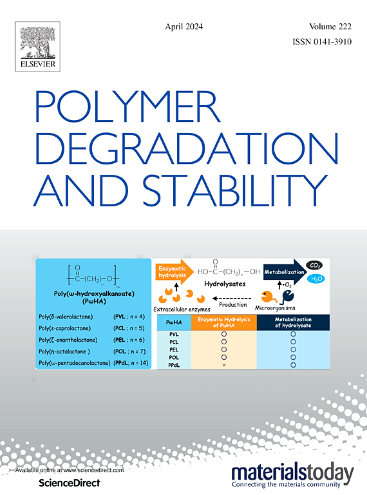A high-molecular-weight flame retardant derived from bis[tetrakis(hydroxymethyl)phosphonium] sulfate for cotton fabrics
IF 7.4
2区 化学
Q1 POLYMER SCIENCE
引用次数: 0
Abstract
A high-molecular-weight flame retardant, bis[tetrakis(hydroxymethyl)phosphonium] (THPS)-urean-(PO3)(NH4)2, was synthesized for cotton fabrics. Fourier-transform infrared spectroscopy, nuclear magnetic spectroscopy, scanning electron microscopy, and X-ray photoelectron spectroscopy analyses confirmed that (THPS-urea)n-(PO3)(NH4)2 effectively infiltrated the fibers and grafted onto cellulose through N–P(=O)–O–C covalent bonds. The fabric treated with 30 wt% of (THPS-urea)n-(PO3)(NH4)2 (C30) had a limiting oxygen index of 46.8 %. Even after 50 laundering cycles according to the AATCC 61-2013 3A standard, C30 maintained a limiting oxygen index of 39.8 %. Thermogravimetric-Fourier-transform infrared spectrometry, thermogravimetry, and cone calorimetry tests revealed that C30 exhibited excellent flame retardancy. Upon exposure to flame, C30 formed a stable char layer, which prevented the spread of heat and combustible gases. Additionally, C30 was free of formaldehyde, making it suitable for producing infant textiles. After grafting with the flame retardant, C30 retained its mechanical properties. The high-molecular-weight flame retardant enhanced the flame resistance and durability of cotton materials owing to its numerous N–P(=O) (ONH4)2 groups, which facilitated a condensed-phase flame retardancy mechanism.

用于棉织物的双[四(羟甲基)膦]硫酸盐高分子量阻燃剂
为棉织物合成了一种高分子量阻燃剂--双[四(羟甲基)膦](THPS)-脲-(PO3)(NH4)2。傅立叶变换红外光谱、核磁光谱、扫描电子显微镜和 X 射线光电子能谱分析证实,(THPS-脲)n-(PO3)(NH4)2 能有效渗入纤维,并通过 N-P(=O)-O-C 共价键接枝到纤维素上。使用 30 wt%(THPS-脲)n-(PO3)(NH4)2(C30)处理的织物的极限氧指数为 46.8%。即使按照 AATCC 61-2013 3A 标准洗涤 50 次后,C30 的极限氧指数仍保持在 39.8%。热重-傅立叶变换红外光谱法、热重法和锥形量热法测试表明,C30 具有优异的阻燃性。暴露在火焰中时,C30 会形成稳定的炭层,从而阻止热量和可燃气体的扩散。此外,C30 不含甲醛,因此适用于生产婴儿纺织品。与阻燃剂接枝后,C30 仍能保持其机械性能。这种高分子量阻燃剂由于含有大量 N-P(=O) (ONH4)2 基团,促进了凝聚相阻燃机制,从而提高了棉材料的阻燃性和耐用性。
本文章由计算机程序翻译,如有差异,请以英文原文为准。
求助全文
约1分钟内获得全文
求助全文
来源期刊

Polymer Degradation and Stability
化学-高分子科学
CiteScore
10.10
自引率
10.20%
发文量
325
审稿时长
23 days
期刊介绍:
Polymer Degradation and Stability deals with the degradation reactions and their control which are a major preoccupation of practitioners of the many and diverse aspects of modern polymer technology.
Deteriorative reactions occur during processing, when polymers are subjected to heat, oxygen and mechanical stress, and during the useful life of the materials when oxygen and sunlight are the most important degradative agencies. In more specialised applications, degradation may be induced by high energy radiation, ozone, atmospheric pollutants, mechanical stress, biological action, hydrolysis and many other influences. The mechanisms of these reactions and stabilisation processes must be understood if the technology and application of polymers are to continue to advance. The reporting of investigations of this kind is therefore a major function of this journal.
However there are also new developments in polymer technology in which degradation processes find positive applications. For example, photodegradable plastics are now available, the recycling of polymeric products will become increasingly important, degradation and combustion studies are involved in the definition of the fire hazards which are associated with polymeric materials and the microelectronics industry is vitally dependent upon polymer degradation in the manufacture of its circuitry. Polymer properties may also be improved by processes like curing and grafting, the chemistry of which can be closely related to that which causes physical deterioration in other circumstances.
 求助内容:
求助内容: 应助结果提醒方式:
应助结果提醒方式:


